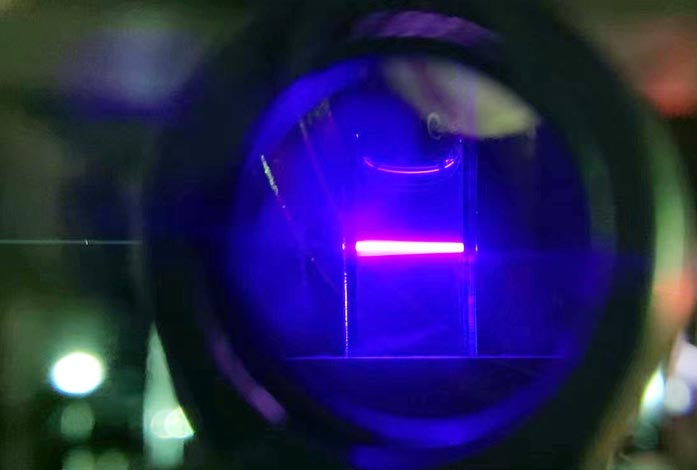Rapid spin-flip in colloidal nanocrystals to generate molecular triplets

White light triplet-fusion photon upconversion using nanocrystal-molecule hybrids
Credit: Chem
A research group led by Prof. WU Kaifeng from the Dalian Institute of Chemical Physics (DICP) of the Chinese Academy of Sciences (CAS) revealed the mechanism for molecular spin-triplets formation from rapid spin-flip in colloidal nanocrystals and demonstrated its photochemical applications.
The study was published in Chem on March 24.
Traditionally, semiconductor spin properties are a territory of physics. Recent developments in solution-grown semiconductor materials, such as lead halide perovskites and colloidal nanocrystals, start to include chemists into this game. But the spin relaxation lifetimes of these materials are still too short (typically a few picoseconds at room temperature) for spintronic and quantum information technology applications.
Importantly, however, there is a big field called “molecular photochemistry” that is particularly fond of spin-relaxed molecular triplet states. Photochemists have spent a lot of efforts in the synthesis of special molecules called sensitizers that can produce triplets upon photoexcitation.
“We realized that the short spin lifetimes recently measured in colloidal nanocrystals should instead find immediate applications in molecular photochemistry,” said Prof. WU.
The researchers demonstrated spin-enabled photochemistry using CsPbBr3 nanocrystals surface-anchored with rhodamine B molecules. Using advanced femtosecond laser spectroscopy, they found that excitation of either the nanocrystal or the molecule induced efficient charge separation, and the rapid spin-flip of the carrier inside the nanocrystal enabled the high-yield formation of molecular triplets through charge recombination. In contrast, the conventional mechanism of heavy-atom effect was ruled out for this system.
Moreover, using the dual triplet-formation pathways and the complementary spectral coverage of CsPbBr3 and rhodamine B, they achieved efficient white-light-driven molecular triplet photochemistry, including triplet-fusion photon upconversion and singlet oxygen generation.
“This study opens a new avenue for photochemical applications of solution-processed semiconductor materials,” said Prof. WU. “It may inspire the use of the spin properties of these low-cost materials in more fields.”
The above work was supported by the National Natural Science Foundation of China, the Ministry of Science and Technology of China, and CAS.
Media Contact
Jean Wang
Dalian Institute of Chemical Physics, Chinese Academy Sciences
wangyj@dicp.ac.cn
Office: 41182464221
Media Contact
All latest news from the category: Physics and Astronomy
This area deals with the fundamental laws and building blocks of nature and how they interact, the properties and the behavior of matter, and research into space and time and their structures.
innovations-report provides in-depth reports and articles on subjects such as astrophysics, laser technologies, nuclear, quantum, particle and solid-state physics, nanotechnologies, planetary research and findings (Mars, Venus) and developments related to the Hubble Telescope.
Newest articles

Innovative 3D printed scaffolds offer new hope for bone healing
Researchers at the Institute for Bioengineering of Catalonia have developed novel 3D printed PLA-CaP scaffolds that promote blood vessel formation, ensuring better healing and regeneration of bone tissue. Bone is…

The surprising role of gut infection in Alzheimer’s disease
ASU- and Banner Alzheimer’s Institute-led study implicates link between a common virus and the disease, which travels from the gut to the brain and may be a target for antiviral…

Molecular gardening: New enzymes discovered for protein modification pruning
How deubiquitinases USP53 and USP54 cleave long polyubiquitin chains and how the former is linked to liver disease in children. Deubiquitinases (DUBs) are enzymes used by cells to trim protein…


